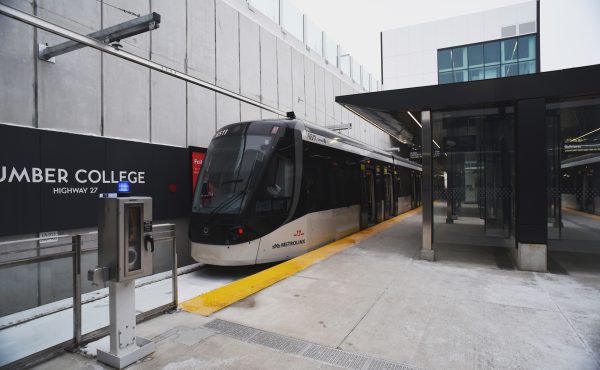
Most people who take transit walk to their transit stop. You would think that transit companies would therefore be very conscious of pedestrian issues, and would make efforts to make sure access to their stops is easy and safe for pedestrians. But often transit companies don’t really think beyond their own system — they don’t take into consideration how people get to their stops. Trying to get the TTC to be aware of pedestrian issues has been a regular source of frustration for Toronto pedestrian activists.
But the situation is far worse in Brazil. I recently became aware of a very interesting project by Dylan Passmore, a planning student at the University of Toronto, who studied the many challenges involved in pedestrian access to transit in one of Brazil’s largest cities: The Missing Leg: The experience of walking to public transit in Sà£o Paulo, Brazil (PDF – 3MB). It makes for a very interesting read about the pedestrian-transit issue, and although there is a great difference in magnitude, some of the issues are also relevant to Toronto. Passmore’s work was supervised by Paul Hess, who was co-author of the important pedestrian study Making Toronto’s Streets.



4 comments
what’s the story with the bus pictured here?
In Halifax last December, I went out to one of the big box malls near where my mom lives. The bus stops were isolated concrete pads with the roadway on one side and an expanse of winter mud-grass on the other, with no practical path from the bus stop to the big box shops. Definitely pedestrian-hostile.
The parkside stop on the queen line (on the queensway) comes to mind as an example. There are no sidewalks along that stretch of the queensway despite recent reconstruction. The entrance to the stop is via a stairway in the parkside underpass. Little working lighting exists in that pedestrian canyon. Motor vehicles regularly roar through at more than 80 kph. Convex mirrors installed to allow the cautious to peer ahead for unwelcome company are broken.
To rub salt into the wounds the structures were designed to discourage people from entering via the queensway. Raised rails with course gravel greet those who do manage to scale the steep banks of the queensway to approach the stop. This is remarkably vindictive motorholic planning at its worst. Who designed this mess anyway? General Motors?
I recently looked at City of Toronto counts of pedestrians at selected intersections. Not surprisingly, most intersections with high pedestrian counts were downtown – the Financial District, Chinatown, Yonge and Bloor. But in the suburbs, there were these areas of very high pedestrian counts surrounded by low counts. These intersections are Jane and Finch, Jane and Wilson, Lawrence and Dufferin, Warden and Sheppard, Victoria Park and Finch. I realized that this was largely due to pedestrians transferring between buses.
Many of these intersections are designed for cars, and not people, and changing buses can be very dangerous. At some intersections, the TTC has near and far side stops, which cuts down on having to cross streets, but at others, it does not. I have seen riders scramble across two sides of an intersection, often against the light, to the the bus that’s sitting kitty-corner to the other stop, hoping it won’t pull away. Pedestrians may have to cross 12-18 lanes, and sit through left-turn signal phases, as well as dodge selfish, impatient and/or clueless drivers that push through yellow and red signals.
In places like Brampton and Mississauga, this situation can be even worse. While most of the time, the TTC has its stops close as possible to the intersection, some of the stops in the 905 are set well back, so that private motorists aren’t too inconvenienced by a stopped bus to make a right turn. Plus these intersections can have dual left-turn lanes (sometimes in all four directions), something that doesn’t exist in Toronto at 4-way intersections. The worst experience I had was to transfer from one bus (1A) at Kennedy and Queen in Brampton to another (7), cross the second street, to see the bus (that’s supposed to wait) pull away, forcing me to wait 40 minutes, and then argue with the next driver about my transfer – that is why these intersections can be so dangerous.
There’s no easy or cheap solution, but this is why road narrowing, better timed signals providing near and far side stops at transfer points and perhaps getting rid of the right turn green arrows that only Metro has that drivers love to push through without stopping when that green light goes red.